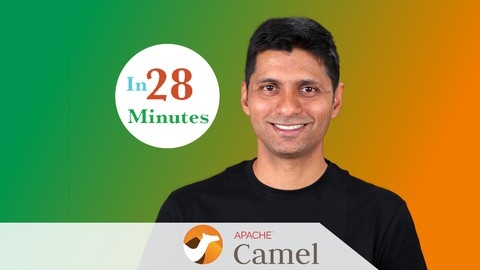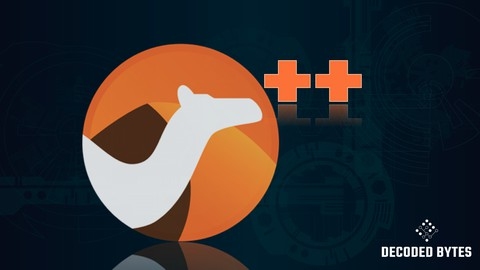Apache Camel is a powerful open-source integration framework that simplifies the process of connecting different systems and applications.
It excels at handling data exchange between various protocols and formats, making it a valuable tool for building robust and scalable enterprise solutions.
By mastering Apache Camel, you can unlock new possibilities for connecting disparate systems, automating workflows, and streamlining data processing.
Finding a high-quality Apache Camel course on Udemy can be a daunting task, especially with so many options available.
You’re looking for a program that provides a comprehensive learning experience, practical hands-on exercises, and real-world applications, all delivered by experienced instructors.
We’ve carefully reviewed numerous courses and based on our analysis, Learn Apache Camel Framework with Spring Boot is the best course overall on Udemy.
This course stands out for its practical approach, focusing on building Camel routes within a Spring Boot environment, equipping you with the skills to build robust, scalable applications.
The course covers essential concepts like data processing, messaging systems, and Enterprise Integration Patterns, ensuring a solid foundation for your journey into the world of Apache Camel.
While Learn Apache Camel Framework with Spring Boot is our top pick, we also have other valuable resources to explore.
Keep reading to discover a curated selection of Apache Camel courses that cater to different learning styles and career goals, whether you’re a beginner or a seasoned developer seeking to expand your expertise.
Learn Apache Camel Framework with Spring Boot
You’ll begin by setting up your development environment with Apache Camel and Spring Boot, getting hands-on right away.
The course then guides you through creating your first Camel routes – the heart of the framework.
You’ll learn how to process data efficiently and flexibly using Spring beans and Camel processors.
One of the course’s strengths lies in its focus on integrating Apache Camel with messaging systems like ActiveMQ and Kafka.
You’ll gain practical experience in sending and receiving messages, transforming data between JSON, XML, and Java objects, and performing essential processing steps within your routes.
This hands-on approach helps you understand the powerful capabilities of Camel for handling diverse message formats in real-world scenarios.
The course also dives deep into Enterprise Integration Patterns (EI Patterns), covering key concepts like Pipeline, Multicast, Content Based Routing, Splitter, Aggregation, Routing Slip, and Dynamic Routing.
You’ll learn how to implement these patterns in your Camel routes, building elegant and reliable solutions for complex integration challenges.
Throughout the course, you’ll gain valuable insights into best practices for building robust and secure Camel applications.
These include dynamic configuration, logging, tracing, Dead Letter Queues, and secure message encryption.
And to top it off, the bonus lecture on Docker provides you with a solid foundation for containerizing your Camel applications, making them portable and easy to deploy.
This course offers a well-structured learning path, covering essential concepts and practical skills.
If you’re ready to take your integration skills to the next level, this course is a great option.
Apache Camel with Springboot Masterclass
You’ll start with the fundamentals, learning to create simple Camel routes and test them with JUnit.
You’ll quickly move on to setting up a basic Spring Boot application and crafting routes for various scenarios, including file transfers, timer-based operations, and mocking endpoints for unit testing.
Next, you’ll dive into essential Camel patterns and components.
You’ll explore the power of inline processors, the Splitter Enterprise Integration Pattern, and learn to use BeanIO to map data to POJOs.
You’ll also gain practical experience externalizing processors into Java classes for better organization and maintainability.
The course guides you through a detailed file poller use case, demonstrating how to transition from legacy file transfer to a REST endpoint and persist data in a MySQL database using JPA and Hibernate.
You’ll build REST endpoints with Apache Camel and interact with MySQL, implementing batch routes to read data from the database and write it to files using named queries.
You’ll even learn to delete records from the database using dynamic routing and native parameterized queries.
Then, you’ll venture into the world of message queues.
The course introduces ActiveMQ and demonstrates how to publish and subscribe to messages.
You’ll learn to leverage the power of messaging for building highly scalable and asynchronous integrations.
Finally, you’ll delve into the Camel Toolkit, mastering techniques for managing and reusing your Camel routes effectively.
You’ll learn to understand the flow of the Camel Exchange and utilize different components like direct, seda, and wireTap for various use cases.
The course also covers tracing Apache Camel routes, gracefully handling exceptions, overriding REST responses, managing REST contracts, and using headers, choices, and conditions with Simple expressions and predicates.
As a bonus, you’ll learn to leverage the Apache Camel website and use DrawIO to visualize your Camel integrations.
This course provides a solid foundation in Apache Camel, equipping you with the knowledge and skills to build sophisticated integration solutions.
You’ll gain hands-on experience with key concepts and tools, enabling you to tackle real-world integration challenges.
Advanced Apache Camel
This course takes you on a deep dive into the powerful world of advanced Apache Camel, equipping you with the skills to build robust and scalable integration solutions.
You’ll start by mastering the control bus, a fundamental mechanism for managing your Camel routes.
This includes delving into route policies, allowing you to fine-tune the behavior of your routes and ensure they operate exactly as intended.
Next, you’ll tackle the crucial concept of clustering, essential for achieving high availability.
This means your applications can handle failures gracefully and keep running even if a component goes down.
You’ll learn how to implement both active-active and active-passive clustering strategies, leveraging shared locks to guarantee data integrity.
The course then delves into complex data processing, introducing you to Drools, a powerful rule engine.
This will enable you to define sophisticated business logic within your integrations, making them even more dynamic and intelligent.
Finally, you’ll explore how to monitor and manage your Apache Camel applications effectively.
You’ll learn to harness the power of JMX (Java Management Extensions) to gain real-time insights into your running applications.
You’ll also discover how to integrate with Spring Boot, a popular framework for building microservices, and utilize Hawtio, a robust web console, for comprehensive monitoring and management of your Camel applications.
The course provides flexibility by teaching you how to write routes using both Java DSL and XML DSL, allowing you to choose the approach that best suits your needs.



